Northrop Grumman B-2 Spirit Videos
|
Loading...
|
|
Northrop Grumman B-2 Spirit
B-2 Spirit
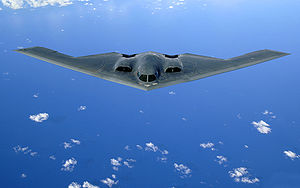
Picture - A USAF B-2 Spirit in flight
Role: Stealth bomber
National origin: United States
Manufacturer: Northrop Corporation
Northrop Grumman
First flight: 17 July 1989
Introduction: April 1997
Status: Active service: 20 aircraft
Primaryuser: United States Air Force
Number built: 21
Program cost: US$44.75 billion (projected through 2004)
Unit cost: $737 million (1997 cost for each aircraft only)
The Northrop Grumman B-2 Spirit (also known as the Stealth Bomber) is an American heavy bomber with "low observable" stealth technology designed to penetrate dense anti-aircraft defenses and deploy both conventional and nuclear weapons. Because of its considerable capital and operational costs, the project was controversial in Congress and among the Joint Chiefs of Staff. During the late 1980s and early 1990s, Congress slashed initial plans to purchase 132 bombers to just 21.
The cost of each aircraft averaged US$737 million in 1997 dollars. Total procurement costs averaged US$929 million per aircraft, which includes spare parts, equipment, retrofitting, and software support. The total program cost, which includes development, engineering and testing, averaged US$2.1 billion per aircraft (in 1997 dollars).
Twenty B-2s are operated by the United States Air Force. Though originally designed in the 1980s for Cold War operations scenarios, B-2s were first used in combat to drop bombs on Serbia during the Kosovo War in 1999, and saw continued use during the ongoing wars in Iraq and Afghanistan. One aircraft was lost in 2008 when it crashed just after takeoff; the crew ejected safely.
The bomber has a crew of two and can drop up to 80 x 500lb (230 kg)-class JDAM GPS-guided bombs, or 16 x 2,400lb (1,100 kg) B83 nuclear bombs in a single pass through extremely dense anti-aircraft defenses. The B-2 is the only aircraft that can carry large air to surface standoff weapons in a stealth configuration. The program has been the subject of espionage and counter-espionage activity and the B-2 has provided prominent public spectacles at air shows since the 1990s.
Development
ATB project
The B-2 Spirit originated from the Advanced Technology Bomber (ATB) black project that began in 1979. The Cold War was long underway, and on the campaign trail in 1979 and 1980, candidate Ronald Reagan promised to restore American military strength. On 22 August 1980, the incumbent Carter administration publicly disclosed that the Department of Defense was working to develop stealth aircraft including the ATB. In 2007, it was revealed publicly that MIT scientists helped assess the mission effectiveness of the aircraft under classified contract during the 1980s.
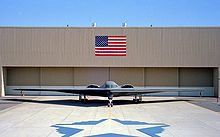
Picture - The B-2's first public display in 1988
After the evaluations of the companies' proposals, the ATB competition was reduced to the Northrop/Boeing and Lockheed/Rockwell teams with each receiving a study contract for further work. Both teams used flying wing designs. The Northrop design was larger while the Lockheed design was smaller and included a small tail. The black project was funded under the code name "Aurora". The Northrop/Boeing team's ATB design was selected over the Lockheed/Rockwell design on 20 October 1981.
The Northrop design received the designation B-2 and the name "Spirit". The bomber's design was changed in the mid-1980s when the mission profile was changed from high-altitude to low-altitude, terrain-following. The redesign delayed the B-2's first flight by two years and added about US$1 billion to the program's cost. An estimated US$23 billion was secretly spent for research and development on the B-2 by 1989. At the program's peak, approximately 13,000 people were employed at a dedicated plant in Pico Rivera, California for the aircraft's engineering and portions of its manufacturing.
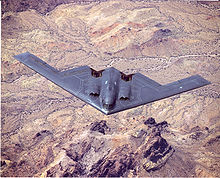
Picture - The B-2's first public flight in 1989
The B-2 was first publicly displayed on 22 November 1988, at Air Force Plant 42, Palmdale, California, where it was assembled. This initial viewing was heavily guarded and guests were not allowed to see the rear of the B-2. Its first public flight was on 17 July 1989 from Palmdale.
Procurement
A procurement of 132 aircraft was planned in the mid-1980s, but was later reduced to 75. By the early 1990s, the Soviet Union had disintegrated, which effectively rendered void the Spirit's primary Cold War mission. In light of budgetary pressures and congressional opposition, in his 1992 State of the Union Address, President George H.W. Bush announced B-2 production would be limited to a total of 20 aircraft. In 1996, however, the Clinton administration, though originally committed to ending production of the bombers once the 20th aircraft was completed, authorized the conversion of a 21st bomber, a prototype test model, to Block 30 full operational status at a cost of nearly $500 million.
In 1995 Northrop made a proposal to the USAF to build 20 additional aircraft with a flyaway cost of $566M each.
Espionage
In 1984 a Northrop employee, Thomas Cavanaugh, was arrested for trying to sell classified information to the Soviet Union, which apparently was smuggled out of the Pico Rivera, California factory. Cavanaugh was eventually sentenced to life in prison and released under parole in 2001.
Noshir Gowadia, a design engineer who worked on the B-2's propulsion system, was arrested in October 2005 for selling B-2 related classified information to foreign countries. His trial was initially scheduled for 12 February 2008, but he received a continuance. On August 9, 2010, Gowadia was convicted in the United States District Court for the District of Hawaii on 14 of 17 charges against him. Sentencing has been set for November 22, 2010.
Program costs
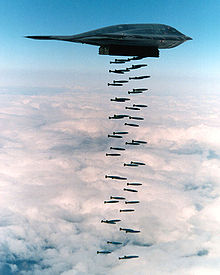
Picture - In a 1994 live fire exercise near Point Mugu, California, a B-2 drops forty-seven 500lb (230 kg) class Mark 82 bombs, which is more than half of a B-2's total ordnance payload
The program was the subject of public controversy for its costs to American taxpayers. In 1996 the General Accounting Office disclosed that the USAF's B-2 bombers "will be, by far, the most costly bombers to operate on a per aircraft basis", costing over three times as much as the B-1B (US$9.6 million annually) and over four times as much as the B-52H ($US6.8 million annually). In September 1997, each hour of B-2 flight necessitated 119 hours of maintenance in turn. Comparable maintenance needs for the B-52 and the B-1B are 53 and 60 hours respectively for each hour of flight. A key reason for this cost is the provision of air-conditioned hangars large enough for the bomber's 172ft (52.4m) wingspan, which are needed to maintain the aircraft's stealthy properties, especially its "low-observable" stealthy skins. Maintenance costs are about $3.4 million a month for each aircraft.
The total "military construction" cost related to the program was projected to be US$553.6 million in 1997 dollars. The cost to procure each B-2 was US$737 million in 1997 dollars, based only on a fleet cost of US$15.48 billion. The procurement cost per aircraft as detailed in General Accounting Office (GAO) reports, which include spare parts and software support, was $929 million per aircraft in 1997 dollars.
The total program cost projected through 2004 was US$44.75 billion in 1997 dollars. This includes development, procurement, facilities, construction, and spare parts. The total program cost averaged US$2.13 billion per aircraft.
Opposition
In its consideration of the fiscal year 1990 defense budget, the House Armed Services Committee trimmed $800 million from the B-2 research and development budget, while at the same time staving off a motion to kill the bomber. Opposition in committee and in Congress more largely was broad and bipartisan, with Congressmen Ron Dellums (D-CA), John Kasich (R-OH), and John G. Rowland (R-CT) authorizing the motion to kill the bomber and others in the Senate such as Jim Exon (D-NE) and John McCain (R-AZ) also opposing the project.
The growing cost of the B-2 program, and evidence of flaws in the aircraft's ability to elude detection by radar, were among factors which drove opposition. At the peak production period specified in 1989, the schedule called for spending US$7 billion to $8 billion per year in 1989 dollars, something Committee Chair Les Aspin (D-WI) said "won't fly financially."
In 1990, the US Department of Defense accused Northrop of using faulty components in the flight control system. Efforts have also been made to reduce the probability of bird ingestion, which could damage engine fan blades.
In time, a number of prominent members of Congress began to oppose the program's expansion, to include former Democratic presidential nominee John Kerry who cast votes against the B-2 Stealth Bomber in 1989, 1991 and 1992 while a United States Senator representing Massachusetts. By 1992, Republican President George H.W. Bush called for the cancellation of the B-2 and promised to cut military spending by 30% in the wake of the collapse of the Soviet Union.
In May 1995, on the basis of its 1995 Heavy Bomber Force Study, the DOD determined that additional B-2 procurements would exacerbate efforts to develop and implement long term recapitalization plans for the USAF bomber force.
In October 1995, former Chief of Staff of the United States Air Force, General Mike Ryan, and Former Chairman of the Joint Chiefs of Staff, General John Shalikashvili, strongly recommended against Congressional action to fund the purchase of any additional B-2s, arguing that to do so would require unacceptable cuts in existing conventional and nuclear-capable aircraft to pay for the new bombers, and because the military had much higher priorities on which to spend its limited procurement dollars.
Some B-2 advocates argued that procuring twenty additional B-2s would save money because B-2s would be able to deeply penetrate anti-aircraft defenses and use low-cost, short-range attack weapons rather than expensive standoff weapons. However, in 1995, the Congressional Budget Office (CBO), and its Director of National Security Analysis, found that additional B-2s would reduce the cost of weapons expended by the bomber force by less than US$2 billion in 1995 dollars during the first two weeks of a conflict, which is when the Air Force envisions bombers would make their greatest contribution. This is a small fraction of the US$26.8 billion (in 1995 dollars) life cycle cost that the CBO projected an additional 20 B-2s would cost.
In 1997, as Ranking Member of the House Armed Services Committee and National Security Committee, Congressman Ron Dellums, a long-time opponent of the bomber, cited five independent studies and offered an amendment to that year's defense authorization bill to cap production of the bombers with the existing 21 aircraft. The amendment was narrowly defeated. Nonetheless, Congress has never approved funding for the purchase of any additional B-2 bombers to date.
Upgrades
In 2004, Northrop Grumman tested a new alternate high-frequency material (AHFM) for use as a Radar-absorbent material coating for the B-2.
In 2008, the US Congress funded upgrades to the B-2s weapon control systems for hitting moving targets.
On 29 December 2008, Air Force officials awarded a production contract to Northrop Grumman to modernize the B-2 fleet's radar. The contract provides advanced state-of-the-art radar components, with the aim of sustained operational viability of the B-2 fleet into the future. The contract has a target value of approximately US$468 million. The award follows successful flight testing with the upgraded equipment. A modification to the radar was needed since the U.S. Department of Commerce required the B-2 to use a different radar frequency. It was reported on 22 July 2009 that the B-2 had passed the second of the two USAF audit milestones associated with this upgraded AESA radar capability.
On 28 April 2009, an Air Force/contractor team verified that the 30,000 pound Massive Ordnance Penetrator (MOP) would fit in the B-2's bomb bay.
Design
Picture - The B-2's engines are buried within its wing to conceal the induction fans and minimize their exhaust signature. The crew of two sit side-by-side in the cockpit.
The B-2's low-observable, or "stealth", characteristics give it the ability to penetrate an enemy's most sophisticated anti-aircraft defenses to attack its most heavily defended targets. The bomber's stealth comes from a combination of reduced acoustic, infrared, visual and radar signatures, making it difficult for opposition defenses to detect, track and engage the aircraft. Many specific aspects of the low-observability process remain classified. The B-2's composite materials, special coatings and flying wing design, which reduces the number of leading edges, contribute to its stealth characteristics. The Spirit has a radar signature of about 0.1m. Each B-2 requires a climate-controlled hangar large enough for its 172-foot (52 m) wingspan to protect the operational integrity of its sophisticated radar absorbent material and coatings. The engines are buried within the wing to conceal the induction fans and hide their exhaust.
The blending of low-observable technologies with high aerodynamic efficiency and large payload gives the B-2 significant advantages over previous bombers. The U.S. Air Force reports its range as approximately 6,000 nautical miles (6,900 mi; 11,000 km). Also, its low-observation ability provides the B-2 greater freedom of action at high altitudes, thus increasing its range and providing a better field of view for the aircraft's sensors. It combines GPS Aided Targeting System (GATS) with GPS-aided bombs such as Joint Direct Attack Munition (JDAM). This uses its passive electronically scanned array APQ-181 radar to correct GPS errors of targets and gain much better than laser-guided weapon accuracy when "dumb" gravity bombs are equipped with a GPS-aided "smart" guidance tail kit. It can bomb 16 targets in a single pass when equipped with 1,000 or 2,000-pound (450kg or 900kg) bombs, or as many as 80 when carrying 500lb (230 kg) bombs.
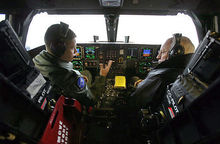
Picture - Vice President Dick Cheney sits inside the cockpit of a B-2 with pilot Capt. Luke Jayne during a visit to Whiteman AFB in 2006.
The B-2 has a crew of two: a pilot in the left seat, and mission commander in the right. The B-2 has provisions for a third crew member if needed. For comparison, the B-1B has a crew of four and the B-52 has a crew of five. B-2 crews have been used to pioneer sleep cycle research to improve crew performance on long sorties. The B-2 is highly automated, and, unlike two-seat fighters, one crew member can sleep, use a toilet or prepare a hot meal while the other monitors the aircraft.
As with the B-52 Stratofortress and B-1 Lancer, the B-2 provides the versatility inherent in manned bombers. Like other bombers, its assigned targets can be canceled or changed while in flight, the particular weapon assigned to a target can be changed, and the timing of attack, or the route to the target can be changed while in flight.
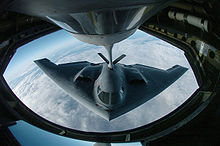
Picture - A B-2 during aerial refueling which extends its range past 6,000 miles to support intercontinental sorties.
The prime contractor, responsible for overall system design, integration and support, is Northrop Grumman. Boeing, Raytheon (formerly Hughes Aircraft), G.E. and Vought Aircraft Industries, are subcontractors.
The original B-2 design had tanks for a contrail-inhibiting chemical, but this was replaced in the final design with a contrail sensor from Ophir that alerts the pilot when he should change altitude and mission planning also considers altitudes where the probability of contrail formation is minimized.
Operational history
The first operational aircraft, christened Spirit of Missouri, was delivered to Whiteman Air Force Base, Missouri, where the fleet is based, on 17 December 1993. The B-2 reached initial operational capability (IOC) on 1 January 1997. Depot maintenance for the B-2 is accomplished by U.S. Air Force contractor support and managed at Oklahoma City Air Logistics Center at Tinker Air Force Base. Originally designed to deliver nuclear weapons, modern usage has shifted towards a flexible role with conventional and nuclear capability.
Into combat

Picture - An Air Force maintenance crew services a B-2 at Andersen AFB, Guam, 2004
The B-2 has seen service in three campaigns. Its combat debut was during the Kosovo War in 1999. It was responsible for destroying 33% of selected Serbian bombing targets in the first eight weeks of U.S. involvement in the War. During this war, B-2s flew non-stop to Kosovo from their home base in Missouri and back. The B-2 was the first aircraft to deploy GPS satellite guided JDAM "smart bombs" in combat use in Kosovo.
The B-2 has been used to drop bombs on Afghanistan in support of the ongoing War in Afghanistan. With the support of aerial refueling, the B-2 flew one of its longest missions to date from Whiteman Air Force Base, Missouri to Afghanistan and back.

Picture - B-2 Spirit United States Air Force video
During the ongoing War in Iraq, B-2s have operated from Diego Garcia and an undisclosed "forward operating location". Other sorties in Iraq have launched from Whiteman AFB. This resulted in missions lasting over 30 hours and one mission of over 50 hours. The designated "forward operating locations" have been previously designated as Guam and RAF Fairford, where new climate controlled hangars have been constructed. B-2s have conducted 27 sorties from Whiteman AFB and 22 sorties from a forward operating location, releasing more than 1.5 million pounds of munitions, including 583 JDAM "smart bombs" in 2003.
The B-2's combat use preceded a U.S. Air Force declaration of "full operational capability" in December 2003. The Pentagon's Operational Test and Evaluation 2003 Annual Report noted that the B-2's serviceability for Fiscal Year 2003 was still inadequate, mainly due to the maintainability of the B-2's low observable coatings. The evaluation also noted that the Defensive Avionics suite also had shortcomings with pop-up threats.
All B-2s, nuclear-capable B-52s, and nuclear intercontinental ballistic missiles have shifted to the nuclear-focused Air Force Global Strike Command set up on September 2009.
Operators

Picture - The "Spirit of Indiana" sits on the ramp at Andersen AFB in Guam on 23 June 2006
B-2s are operated exclusively by the United States Air Force active units.
United States Air Force
509th Bomb Wing, Whiteman Air Force Base (currently has 19 B-2s)
393d Bomb Squadron
394th Combat Training Squadron
131st Bomb Wing, Whiteman Air Force Base (Missouri Air National Guard)
110th Bomb Squadron
412th Test Wing, Edwards Air Force Base (currently has 1 B-2)
419th Flight Test Squadron
53d Wing, Eglin Air Force Base (former)
72d Test and Evaluation Squadron, Whiteman Air Force Base
57th Wing, Nellis Air Force Base (former)
325th Weapons Squadron, Whiteman Air Force Base
715th Weapons Squadron (inactivated)
Accident
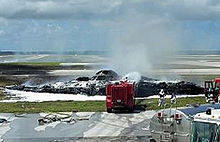
Picture - The crashed B-2
On 23 February 2008, a B-2 crashed on the runway shortly after takeoff from Andersen Air Force Base in Guam. The Spirit of Kansas, 89-0127 had been operated by the 393rd Bomb Squadron, 509th Bomb Wing, Whiteman Air Force Base, Missouri, and had logged 5,176 flight hours. It was the first crash of a B-2. The two person crew ejected from the aircraft and survived the crash. The aircraft was completely destroyed, a hull loss valued at US$1.4 billion. After the accident, the Air Force took the B-2 fleet off operational status until clearing the fleet for flight status 53 days later on 15 April 2008.
Aircraft on display
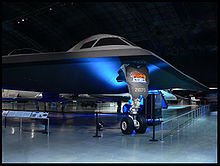
Picture - Mockup of a B-2 Spirit on display at the National Museum of the United States Air Force
Because of its high cost, strategic bombing role, and the still-classified aspects of its low observable coatings, no production B-2 has been placed on permanent display. However, B-2s have made periodic appearances on ground display at various air shows.
In 2004, one of the test articles (s/n AT-1000) built without engines or instruments for static testing was placed on display at the National Museum of the United States Air Force near Dayton, Ohio. The test article passed all structural testing. The Museum's restoration team spent over a year reassembling the fractured airframe.
From 1989 to 2004, the South Dakota Air and Space Museum located on the grounds of Ellsworth Air Force Base displayed the 10-short-ton (9-metric-ton) "Honda Stealth", a 60% scale mockup of a stealthy bomber which had been built by North American Honda in 1988 for an advertising campaign. Although not an actual replica of a B-2, the mock-up was close enough to the B-2's design to arouse suspicion that Honda had intercepted classified, top secret information, as the B-2 project was still officially classified in 1988. Honda donated the model to the museum in 1989, on condition that the model be destroyed if it was ever replaced with a different aircraft. In 2005, when the museum received a B-1 Lancer for display (Ellsworth being a B-1 base), the museum destroyed the mock-up.
Specifications (B-2A Block 30)
Data from USAF Fact Sheet, Pace, Spick, Globalsecurity
General characteristics
Crew: 2
Length: 69 ft (21.0 m)
Wingspan: 172 ft (52.4 m)
Height: 17 ft (5.18 m)
Wing area: 5,140ft² (478m²)
Empty weight: 158,000 lb (71,700 kg)
Loaded weight: 336,500 lb (152,200 kg)
Max takeoff weight: 376,000 lb (170,600 kg)
Powerplant: 4x— General Electric F118-GE-100 non-afterburning turbofans, 17,300 lbf (77 kN) each
Performance
Maximum speed: Mach 0.95 (525 knots, 604 mph, 972 km/h)
Cruise speed: Mach 0.85 (470 knots, 541 mph, 870 km/h)
Range: 6,000 nmi (11,100km (6,900 mi))
Service ceiling: 50,000 ft (15,200 m)
Wing loading: 67.3 lb/ft² (329 kg/m²)
Thrust/weight: 0.205
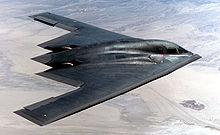
Picture - Side view of a B-2 Spirit
Armament
2 internal bays for 50,000lb (23,000 kg) of ordnance.
80x— 500 lb class bombs (Mk-82) mounted on Bomb Rack Assembly (BRA)
36x— 750 lb CBU class bombs on BRA
16x— 2000 lb class weapons (Mk-84, JDAM-84, JDAM-102) mounted on Rotary Launcher Assembly (RLA)
16x— B61 or B83 nuclear weapons on RLA
Later avionics and equipment improvements allow B-2A to carry JSOW, GBU-28, and GBU-57A/Bs as well. The Spirit is also designated as a delivery aircraft for the AGM-158 JASSM when the missile enters service.
List of B-2 bombers
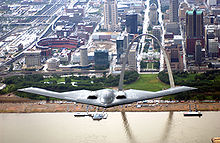
Picture - B-2 in flight over the Mississippi River (St. Louis, Missouri) with the Gateway Arch and Busch Stadium in the background
Sources: FAS.org, B-2 Spirit (Pace)
Bibliography
Picture - B-2 from below
Donald, David, ed. Black Jets: The Development and Operation of America's Most Secret Warplanes. Norwalk, Connecticut: AIRtime Publishing Inc., 2003. ISBN 1-880588-67-6.
Eden, Paul. "Northrop Grumman B-2 Spirit". Encyclopedia of Modern Military Aircraft. New York: Amber Books, 2004. ISBN 1-90468-784-9.
Goodall, James C. "The Northrop B-2A Stealth Bomber." America's Stealth Fighters and Bombers: B-2, F-117, YF-22, and YF-23. St. Paul, MN: MBI Publishing Company, 1992. ISBN 0-87938-609-6.
Pace, Steve. B-2 Spirit: The Most Capable War Machine on the Planet. New York: McGraw-Hill, 1999. ISBN 0-07-134433-0.
Richardson, Doug. Northrop B-2 Spirit (Classic Warplanes). New York: Smithmark Publishers Inc., 1991. ISBN 0-8317-1404-2.
Sorenson, David, S. The Politics of Strategic Aircraft Modernization. New York: Greenwood Publishing Group, 1995 ISBN 978-0275952587.
Spick, Mike. "B-2 Spirit", The Great Book of Modern Warplanes. St. Paul, Minnesota: MBI Publishing Company, 2000. ISBN 0-7603-0893-4.
Winchester, Jim, ed. "Northrop B-2 Spirit". Modern Military Aircraft (Aviation Factfile). Rochester, Kent, UK: Grange Books plc, 2004. ISBN 1-84013-640-5.
The World's Great Stealth and Reconnaissance Aircraft. New York: Smithmark, 1991. ISBN 0-8317-9558-1.
Living Warbirds: The best warbirds DVD series.
Source: WikiPedia